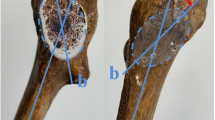Abstract
Purpose
Medial femoral neck fractures are common, and closed reduction and internal fixation by three cannulated screws is an accepted method for the surgical treatment. Computer navigation for screw placement may reduce fluoroscopy time, the number of guidewire passes and optimise screw placement.
Methods
In the context of a sawbone study, a computer-assisted planning and navigation system based on 3D-imaging for guidewire placement in the femoral neck was tested to improve screw placement. Three screws were inserted into 12, intact, femoral sawbones using the conventional technique and into 12, intact, femoral sawbones guided by the computer-based navigation system. Guidewire and subsequent screw placement in the femoral neck were evaluated.
Results
Use of the navigation system resulted in a significant reduction of the number of drilling attempts (p ≤ 0.05) and achieved optimised accuracy of implant placement by attaining significantly better screw parallelism (p ≤ 0.05) and significantly enlarged neck-width coverage by the three screws (p ≤ 0.0001). Computer assistance significantly increased the number of fluoroscopic images (p ≤ 0.001) and the operation time (p ≤ 0.0001).
Conclusions
Three-dimensional computer-assisted navigation improves accuracy of cannulated screw placement in femoral neck while increasing the number of fluoroscopic images and operation time. Additional studies including fractured sawbones and cadaver models with the goal of reducing operation time are indispensable before introduction of this navigation system into clinical practice.




Similar content being viewed by others
References
Kannus P, Niemi S, Parkkari J, Palvanen M, Vuori I, Järvinen M (1999) Hip fractures in Finland between 1970 and 1977 and predictions for the future. Lancet 353:802–805
Selvan VT, Oakley MJ, Rangan A, Al-Lami MK (2004) Optimum configuration of cannulated hip screws for the fixation of intracapsular hip fractures: a biomechanical study. Injury 35:136–141
Kloen P, Rubel IF, Lyden JP, Helfet DL (2003) Subtrochanteric fracture after cannulated screw fixation of femoral neck fractures: a case report of four cases. J Orthop Trauma 17:225–229
Lindequist S, Tornkvist H (1995) Quality of reduction and cortical screw support in femoral neck fractures. An analysis of 72 fractures with a new computerized measuring method. J Orthop Trauma 9:215–221
Szita J, Cserhati P, Bosch U, Manninger J, Bodzay T, Fekete K (2002) Intracapsular femoral neck fractures: the importance of early reduction and stable osteosynthesis. Injury 33:41–46
Mehlman CT, DiPasquale TG (1997) Radiation exposure to the orthopaedic surgical team during fluoroscopy: “how far away is far enough?”. J Orthop Trauma 11:392–398
Sanders R, Koval KJ, Di Pasquale T, Schmelling G, Stenzler S, Ross E (1993) Exposure of the orthopaedic surgeon to radiation. J Bone Joint Surg [Am] 75:326–330
Kendoff D, Citak M, Gardner MJ, Kfuri M Jr, Thumes B, Krettek C, Hüfner T (2007) Three-dimensional fluoroscopy for evaluation of articular reduction and screw placement in calcaneal fractures. Foot Ankle Int 28:1165–1171
Kotsianos D, Rock C, Euler E, Wirth S, Linsenmaier U, Brandl R, Mutschler W, Pfeifer KJ (2001) 3-D imaging with a mobile surgical image enhancement equipment (ISO-C-3D). Initial examples of fracture diagnosis of peripheral joints in comparison with spiral CT and conventional radiography. Unfallchirurg 104:834–838
Wendl K, von Recum J, Wentzensen A, Grützner PA (2003) Iso-C 3D assisted navigated implantation of pedicle screws in thoracic lumbar vertebrae. Unfallchirurg 106:907–913
Stöckle U, König B, Schaser K, Melcher I, Haas NP (2003) CT and fluoroscopy based navigation in pelvic surgery. Unfallchirurg 106:914–920
Stöckle U, Schaser K, König B (2007) Image guidance in pelvic and acetabular surgery—expectations, success and limitations. Injury 38:450–462
Hamelinck HKM, Haagmans M, Snoeren MM (2006) Safety of computer-assisted surgery for cannulated hip screws. Clin Orthop Rel Res 455:241–245
Mayman D, Vasarhelyi EM, Long W, Ellis RE, Rudan J, Pichora DR (2005) Computer-assisted guidewire insertion for hip fracture fixation. J Orthop Trauma 19:610–615
Suhm N, Beck T, Zuna I, Marazzi C, Staedele H, Jacob AL, Messmer P, Regazzoni P (2004) Fluoroscopy-based surgical navigation versus fluoroscopic guidance to control guide wire insertion for osteosynthesis of femoral neck fractures. Eur J Trauma 1:23–28
Mueller MC, Belei P, de la Fuente M, Strake M, Weber O, Burger C, Radermacher K, Wirtz DC (2011) Evaluation of a fluoroscopy-based navigation system enabling a virtual radiation-free preview of X-ray images for placement of cannulated hip screws. A cadaver study. Comp Aided Surg 16:22–31
Gurusamy K, Parker MJ, Rowlands TK (2005) The complications of displaced intracapsular fractures of the hip: the effect of screw positioning and angulation on fracture healing. J Bone Joint Surg Br 87:632–634
Liebergall M, Ben-David D, Weil Y, Peyser A, Mosheiff R (2006) Computerized navigation for the internal fixation of femoral neck fractures. J Bone Joint Surg [Am] 88:1748–1754
Kendoff D, Hüfner T, Citak M, Maier C, Wesemeier F, Pearle A, Krettek C (2006) A new parallel drill guide for navigating femoral neck screw placement. Development and evaluation. Unfallchirurg 109:875–880
Rock C, Kotsianos D, Linsenmaier U, Fischer T, Brandl R, Vill F, Wirth S, Kaltschmidt R, Euler E, Pfeifer KJ, Reiser M (2002) Studies on image quality, high contrast resolution and dose for the axial skeleton and limbs with a new, dedicated CT system (ISO-D-3D). Rofo 174:170–176
Kwong L, Johanson PH, Zinar DM, Lenihan MR, Herman MW (1990) Shielding of the patient’s gonads during intramedullary interlocking femoral nailing. J Bone Joint Surg [Am] 72:1523–1526
Kendoff D, Bogojevic A, Citak M, Citak M, Maier C, Maier G, Krettek C, Hüfner T (2007) Experimental validation of non-invasive referencing in navigated procedures on long bones. J Orthop Res 25:201–207
Acknowledgements
This study has been funded by the German Federal Ministry of Education and Research (BMBF) within the framework of the research program OrthoMIT through grants BMBF 01EQ0802 and 01IBE02C.
Conflict of interest
The authors declare that they have no conflict of interest
Author information
Authors and Affiliations
Corresponding author
Rights and permissions
About this article
Cite this article
Müller, M.C., Belei, P., Pennekamp, P.H. et al. Three-dimensional computer-assisted navigation for the placement of cannulated hip screws. A pilot study. International Orthopaedics (SICOT) 36, 1463–1469 (2012). https://doi.org/10.1007/s00264-012-1496-7
Received:
Accepted:
Published:
Issue Date:
DOI: https://doi.org/10.1007/s00264-012-1496-7




